Growing & Caring for Papaya Trees
Do you want to plant and grow your own Papaya? Here are some tips that can help.

The Papaya tree (Carica papaya) is a tropical fruit that originated in Mexico and South America. It is now grown throughout the North American tropics and other tropical regions around the world.
The fruit of the Papaya is also called pawpaw and is eaten raw without the skin. The fruit is sweet, low in calories and high in potassium and vitamin A. Papaya is also used in drinks, jellies, salads, desserts and is also dried and candied.
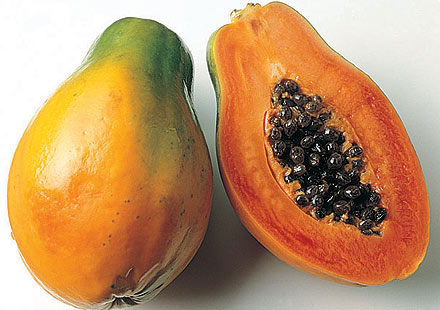
There are many varieties of Papaya, but the main varieties grown in the U.S. are Red Lady, Maradol, and various Solo types. To successfully grow Papayas, you need a frost free climate, lots of sunlight, lots of water and good soil. If you give your plant all of these conditions, then you can grow a papaya from seed and generally have fruit in 6 to 12 months.
Growing Tips for Papayas:
- Climate: Thrive in subtropical and tropical climates. Zone 10 to 11. They do not tolerate freezing temperatures and are damaged or killed if temperatures go below 32 degrees.
- Pollination: The female plants produce fruit and may be cross pollinated with others by insects and wind. There are plants that may be self-pollinating (bi-sexual).
- Growth Habit: The papaya is a short lived, fast growing woody herb. They generally have a single trunk and grow 10 to 15 feet tall, but some plants have been known to grow taller.
- Sun Light: Grow best in full sun. Papayas love the heat and sunlight.
- Fertilize: Papayas are heavy feeders and require regular fertilizing. Adding compost is also recommended.
- Water: Papayas have large soft leaves and evaporate a lot of water in warm weather, so they need above average watering.
- Soil: Papayas do best in rich soil that is high in organic matter. Make sure your planting location and soil has good drainage to avoid root rot.
- Harvesting: Generally, fruit is picked when there is 1/5 to 1/3 color change in the fruit. After picking, keep at room temperature to fully ripen. Ripe fruit will keep 4 to 7 days in the refrigerator.
We currently have Papaya seeds and young plants for sale in the Garden Shoppe and grow the several varieties on the grounds of the Estates. Visit the Edison and Ford Winter Estates Garden Shoppe to see some of the varieties we have available. The horticulture staff is available to assist you and to answer any further questions you may have.
Papaya Smoothie Recipe
Here’s our favorite recipe for Papaya Smoothies:
Papaya Smoothie Recipe
- 2 cups chopped peeled & seeded Papaya
- 1 cup chilled pineapple juice
- 1/2 cup vanilla yogurt
- 1 banana
- 4 ice cubes
- 1 tablespoon honey
- Juice of 1 lime
Combine all ingredients in blender and puree until smooth.
We currently have Papaya seeds and young plants for sale in the Garden Shoppe and grow the several varieties on the grounds of the Estates. Visit the Edison and Ford Winter Estates Garden Shoppe to see some of the varieties we have available. The horticulture staff is available to assist you and to answer any further questions you may have.
For more Recipe Favorites from the Edison and Ford Winter Estates, go to http://efwegardens.wordpress.com/2011/05/21/favorite-recipes-of-the-edison-ford-winter-estates/
Papaya Salsa Recipe
Yum! Our recipe for Papaya Salsa will have you running to the store (or garden) for ingredients!
Papaya Salsa
- 1 Papaya peeled, seeded and chopped.
- 1 cup tomato chopped
- ½ cup cucumber chopped
- ¼ cup onion chopped
- 3 tablespoons fresh lime juice
- 1 tablespoon chopped cilantro
- 1 tablespoon chopped jalapeno(use less to taste)
Combine all ingredients in bowl and mix well. Season with salt and pepper and serve with tortilla chips.
We currently have Papaya seeds and young plants for sale in the Garden Shoppe and grow the several varieties on the grounds of the Estates. Visit the Edison and Ford Winter Estates Garden Shoppe to see some of the varieties we have available. The horticulture staff is available to assist you and to answer any further questions you may have.
For more Recipe Favorites from the Edison and Ford Winter Estates, go to http://efwegardens.wordpress.com/2011/05/21/favorite-recipes-of-the-edison-ford-winter-estates/
Are All Mangoes Created Equal? Delicious Mango Varieties
Are all Mangoes created equal? Try some of the many varieties and experience the variations in flavor, sweetness and texture.
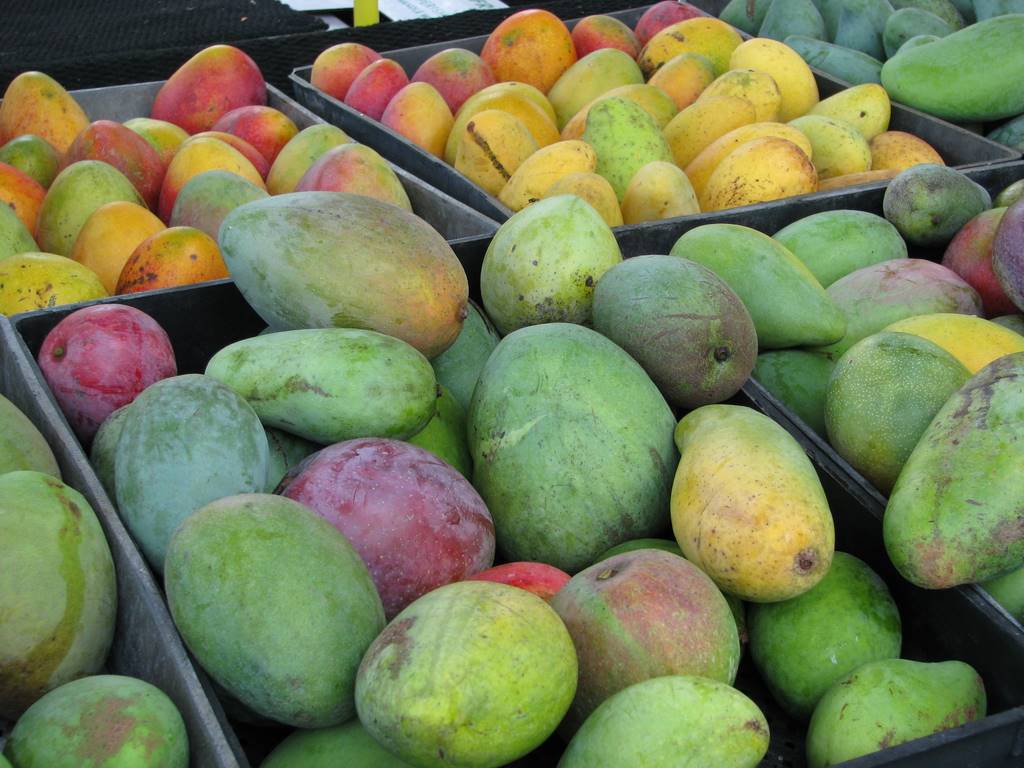
With over a thousand varieties of mangoes in the world, not all them taste the same or offer the same quality. Sample some of the many varieties available at your local produce markets and experience for yourself the varying levels of sweetness and fiber content.
Even though several varieties exist, don’t count on your local supermarket to offer more than one or two. The ‘Tommy Adkins’ variety of mango is most commonly found in supermarkets and is often picked too soon in order to be shipped around the country.
Do yourself a favor this mango season and try some new varieties from your local growers and farmers markets.
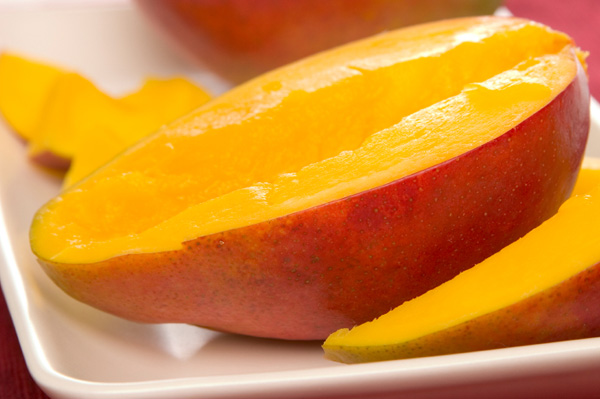
Give these mango varieties a try:
- Kent – Grown in Florida, has a deep orange flesh, flavor is very sweet and rich. A larger mango up to two pounds in weight.
- Keitt – Another popular Florida grown mango that is available later in the season. Its flavor has the taste of peach and vanilla, hints of lime, coconut and berries.
- Baileys Marvel – This mango is firm, has no fiber and has a tangy and sweet flavor. Fruits are 1 to 2 pounds with a peachy blush color. Early to mid-season.
- Valencia Pride – This is one of the more popular mango varieties sold in Florida. The flavor is sweet, aromatic, firm and has no fiber. Never a bad choice.
- Haden – This is one of the first mango cultivars selected in Florida. Haden is a beautifully colored mango with a full sweet flavor. Early season variety.
- Glenn – This variety is a seedling of Haden and is also a Florida favorite. The flavor is slightly peachy and very sweet. Most popular early season mango.
- Nam Doc Mai – This is a delicious variety introduced to Florida from Thailand. It is one of the most desired varieties of Asian mangoes. The fruit is firm, aromatic, has no fiber and is very sweet and is available from June to July.
- Edward – This variety has no fiber, is very sweet and aromatic. It is considered to be one of the finer tasting varieties of Florida mangoes. Golden yellow in color with a reddish blush available from June to July.
The Edison & Ford Estates sells fresh mangoes in season every Thursday at the downtown Ft. Myers Farmers Market from 7 a.m. to 1 p.m. We also have a variety of mango trees available for sale in our Garden Shoppe so you can grow your own mangoes in your backyard.
Mango Smoothie Recipe
Here’s our favorite recipe for Mango Smoothies:
- 1 large mango
- 1 banana (optional)
- ½ cup yogurt
- 1 cup orange juice
- 6 ice cubes
Blend until smooth.
The Edison and Ford Winter Estates sells fresh mangoes in season every Thursday at the downtown Ft. Myers Farmers Market from 7 a.m. to 1 p.m. We also have a variety of mango trees available for sale in our Garden Shoppe so you can grow your own mangoes in your backyard.
For more Recipe Favorites from the Edison and Ford Winter Estates, go to http://efwegardens.wordpress.com/2011/05/21/favorite-recipes-of-the-edison-ford-winter-estates/
Mango Salsa Recipe
Below is our favorite Mango Salsa recipe:
- 1 mango peeled and diced
- ¼ cup red pepper chopped
- ¼ cup sweet onion chopped
- Cilantro chopped to taste
- Juice of 1 lime
- 1 tsp diced jalapeno
- Salt and pepper to taste
Mix all ingredients in bowl, chill and serve with tortilla chips or as an accompaniment on fish.
The Edison and Ford Winter Estates sells fresh mangoes in season every Thursday at the downtown Ft. Myers Farmers Market from 7 a.m. to 1 p.m. We also have a variety of mango trees available for sale in our Garden Shoppe so you can grow your own mangoes in your backyard.
For more Recipe Favorites from the Edison and Ford Winter Estates, go to http://efwegardens.wordpress.com/2011/05/21/favorite-recipes-of-the-edison-ford-winter-estates/
Planting & Care Tips for Your Star Fruit (Carambola) Tree
The Carambola, also called Star Fruit, is a small to medium sized tree that produces a juicy tropical fruit. The flavor combines those of the apple, grape and citrus and is crisp in texture. The fruit can be eaten fresh and is often used in salads and as a garnish due to its unique star shape.
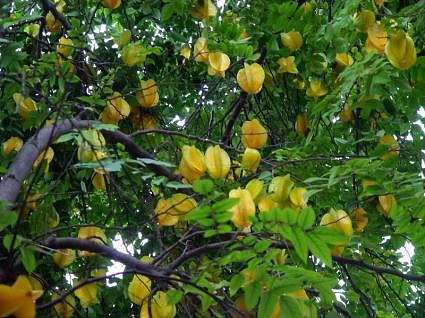
When selecting a Star Fruit be sure it is fully yellow then allow to ripen on your counter until the fruit becomes golden and the ribs begin to brown. Some of the common varieties of Carambola include: King, Bell, Sri Kembangan, Arkin, and Fwang Tung. Once your Star Fruit is mature it is capable of producing up to 200 pounds of fruit a year.
TIPS for Growing Starfruit:
- Temperature: Thrive in subtropical and tropical climates. Zone 10 to 11, but can be grown in zone 9 with protection from frost. Older trees are more tolerant of frost, but growth stops at 55 to 60 degrees and prolonged exposure to temperatures below freezing could kill the tree.
- Best Dooryard Varieties: Arkin is the most commonly grown variety due to it sweeter flavor.
- Avg. Height and Width: Varies with the variety, but Carambola trees range from about 12 to 30 feet tall. They are a smaller tree perfect for the average homeowner’s yard.
- Native Range: Native to Malaysia, Indonesia and Southern China. Commercial production now occurs in Hawaii, Florida and other tropical regions of the world.
- Fertilize: 4 to 5 times a year with balanced liquid fertilizer or use a slow release granular fertilizer several times during the growing season.
- Water: Star Fruit does well with regular watering. Additional watering is not needed during the rainy season.
- Plant in full sun. Trees will do better in an area that is protected or sheltered from the wind.
- Soil: Carambola are not too particular of soil of types, but grow faster and produce more fruit in a soil with more organic matter. Needs good drainage and does not like wet feet.
We currently have the Arkin variety for sale in the Garden Shoppe and grow the Arkin and Fwang Tung varieties on the grounds of the Estates.
Visit the Edison and Ford Winter Estates Garden Shoppe to see some of the varieties we have available. The horticulture staff is available to assist you and to answer any further questions you may have.
Planting and Caring Tips for Your Lychee Tree
The season is upon us for harvesting the fruit of the Lychee tree. Despite the fruits addictive flavor, it remains one of China’s best kept secrets. Lychees have a rough outer skin that separates easily leaving you with a flesh that is sweet to sub-acid, aromatic and tastes unlike anything else on earth.

In SW Florida, fruit is ready for a short time in late May through early July and has a very short shelf life.
The trees were introduced to Florida in the 1930’s and some of the larger commercial groves are in an area southwest of Miami. They grow best in the subtropical climates where temperatures are cool and dry for a short time in the winter months.
Lychees do not like wet feet, so be sure to plant your tree in well drained soil. Trees can also be planted on a mound to ensure proper drainage. The native soil of Florida is fine for successful growing.
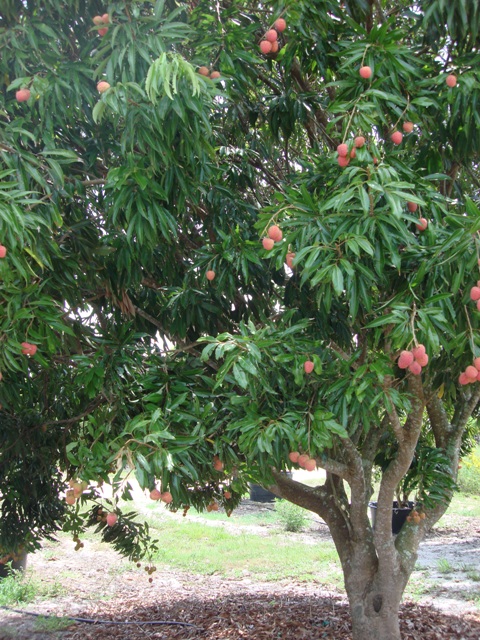
Tips for Growing & Caring for Lychee trees:
- Temperature: Thrive in subtropical environments. Heavy tropical environments may result in no fruit production. Mature trees can withstand a light frost, but prolonged temperatures below 32 degrees may result in damage or even kill the tree.
- Best Dooryard Varieties: Hak Ip, Sweet Heart, Kwai Mai Pink and Mauritius. Commercial varieties such as: Brewster and Emperor are larger trees that may not be suited for a smaller yard.
- Avg. Height and Width: Varies with the variety, Lychee trees range from about 20 to 40 feet tall. Average is 25’ X 25”.
- Native Range: Common in areas of Southern China. Commercial plantations are common in Hawaii and Florida.
- Fertilize established trees regularly 1 to 2 times during the growing season from spring to the end of summer.
- Water: Lychees need regular watering during the growing season. Soils with too much salt in them, especially in the Southwest require regular watering to prevent salt build-up. Lychees should not be in standing water, as it will stunt their growth. Newly planted trees should be watered 2 to 3 times a week during the first weeks of planting, but can be reduced once the tree is established
- Prune mature trees to help control the size and shape. The University of Florida Extension office recommends not cutting branches that are larger than 1 inch, or you risk having less fruit production.
During Lychee season, we will be selling Lychee fruit at the Downtown Farmers Market at Centennial Park Thursdays from 7am to 1pm.
Visit the Edison and Ford Winter Estates Garden Shoppe to see some of the varieties we have available. The horticulture staff is available to assist you and to answer any questions you may have.
Planting and Caring Tips for your Avocado Tree
The Avocado is not your typical fruit because it eats like a vegetable. In Florida, it is often called the Alligator Pear because of the fruit’s shape and rough textured skin.
All Avocados are self pollinating with the male and female flowers occurring on the same tree. The best varieties for the home gardener are: Choquette, Simmonds and Miguel.
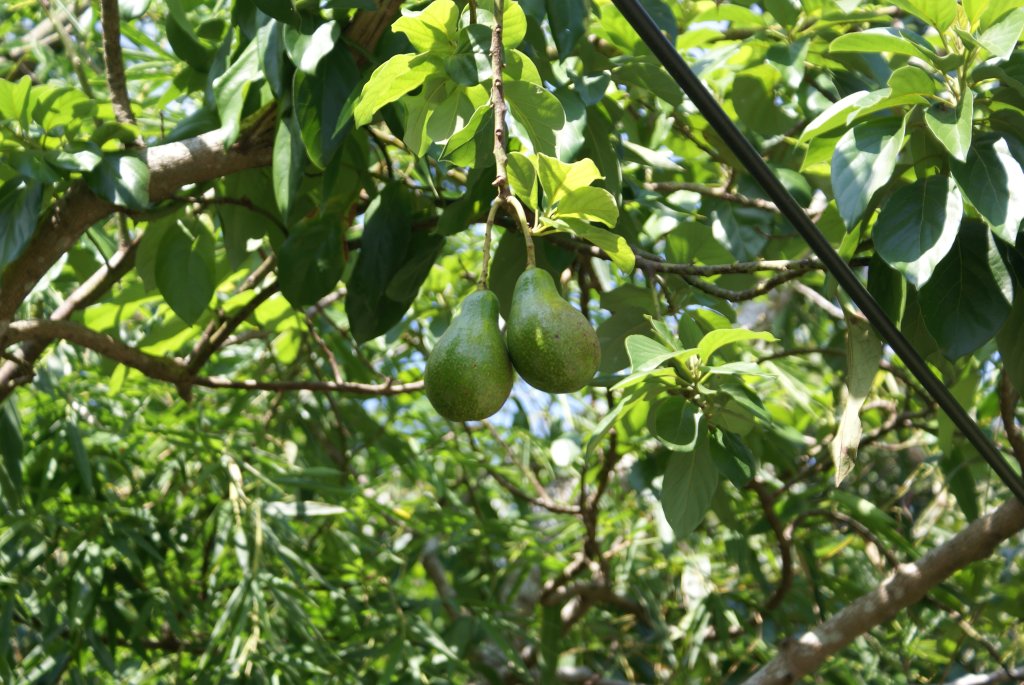
Tips for growing Avocados:
- Soil: Avocado trees do not like wet feet, so be sure to plant your tree in well drained soil. Trees can also be planted on a mound to ensure proper drainage. The native soil of Florida is fine for successful growing.
- Temperature: Avocados are best suited for growing in a lowland tropical climate or frost free subtropical areas along the coast. There are several varieties that are more cold tolerant and may withstand temperatures in the 20’s.
- Most Avocados do not grow true from seed, so the common method of propagation is grafting.
- Fertilizing: Newly planted trees should be fertilized lightly once or twice during the first year, then about 3 to 4 times a year after that. A packaged citrus fertilizer or other common mixes include 6-6-6-2 or 8-3-9-2.
- Water: Newly planted trees should be watered every other day for the first week then 1 to 2 times a week for the first couple of months. In periods of drought, younger trees should be watered twice a week, but can be reduced or stopped once rainy season starts.
- Avocados do not ripen on the tree, so you only need to harvest what you need. The rest can remain on the tree. Mature fruit ripens in about 3 to 8 days once it is removed from the tree.
- A grass free area should be kept 2 to 5 feet out from the trunk of the tree. The best way is to mulch, which will also help retain moisture and improve soil quality at the surface. Keep mulch about 8 to 12 inches from the trunk to prevent rotting of the trunk base
Visit the Edison and Ford Winter Estates Garden Shoppe to see some of the varieties we have available. The Horticulture Staff is available to assist you and to answer any questions you may have.